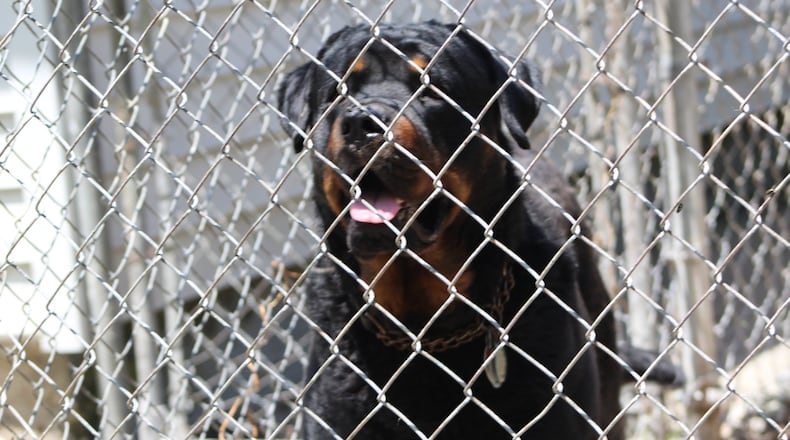But Dayton dog owners have rarely been cited for violating the law. Some citizens say chaining dogs up for prolonged periods of time is a common and troubling occurrence in their neighborhoods and can lead to excessive barking and dog aggression.
The dog that fatally mauled a Dayton man in April was constantly chained up, said Joe Ross, 53, who lives a few doors down from the site of the attack.
“Dogs are supposed to have time to run around, that’s what the species does — it’s just like how the circuses are going away because it’s not natural for (animals),” Ross said.
RELATED: Neighbors were worried about dog that fatally mauled Dayton man
Three years ago, Dayton’s elected leaders voted to change the city’s laws to try to prevent people from tying up their dogs for extended periods of time.
The ordinance, officials said, was intended to improve neighbor relationships and reduce problems related to excessive barking and unsocialized, aggressive and mistreated dogs.
The change also came in the wake of the death of Klonda Richey, who was killed by her neighbors’ dogs on East Bruce Avenue in February 2014. Violating the ordinance is a minor misdemeanor.
RELATED: Dayton to limit dog tethering
Dogs are pack animals and a social species and want to be part of the family and loved, according to animal welfare experts. Dogs that are isolated and stuck on a leash or chain too long can suffer psychological stress and develop problem behaviors.
Some people have dogs that they do not view or treat as pets or part of the family, and instead keep exclusively for security or breeding purposes, said Stephanie Cook, Dayton’s chief prosecutor.
But enforcing the law is challenging because police officers are unlikely to be able to stay in one spot for two or 12 hours to monitor a dog to determine if it is being unlawfully confined, Cook said.
Of the seven citations issued under the city’s new law, several were for violations of other requirements of the ordinance, such as tethers must have a swivel and be a certain length and dogs must have continuous access to water and shelter.
“The biggest barrier to prosecuting this on a regular basis is having a witness who can say this dog was out there for more than two hours or more than 12 hours,” Cook said. “But I think the law comes from a good place, because people were concerned about dogs and their well-being.”
Neighbors are in the best position to know when a dog has been left chained up too long and are encouraged to notify police of violations, Cook said. Officials say helpful evidence can include video footage or time lapsed images of a restrained canine.
RELATED: Still seeking changes to dog laws one year after fatal attack
Ross, co-president of the Jane Reece Neighborhood Association, said too many people in his neighborhood keep their dogs tethered around the clock, including, he said, the owners or caretakers of the pit bull that killed 60-year-old Maurice Brown on April 25.
Ross lives a few doors down from 345 Middle St., which is where the pit bull was chained up in the backyard.
In the early morning hours, as Brown cut through an alley, the dog apparently broke its chain and attacked and killed him.
Police fatally shot the dog; they have not publicly identified its owner or announced charges in the case.
The dog that killed Brown and others confined at the home were well fed and seemed happy to interact with their caretakers and visitors, Ross said.
But they seemed poorly socialized and have bitten people, he said.
Ross said he is aware of the city’s rules on tethering but has not reported violators because he fears retaliation.
The tethering ordinance was crafted to encourage residents to take better care of their companion animals, but enforcement is complaint-based and the city plans to educate more residents about the law through its newsletter and other methods, said Dayton Mayor Nan Whaley.
“We need the citizens’ help,” Whaley said. “We need people to be engaged in their neighborhood and community by calling police on it.”
Raising awareness of the city’s code hopefully would lead to more dog owners to being compliant, but the city’s got to figure out a good way to spread the word among residents, said Linda Leas, a resident of the Belmont neighborhood who was one of the leading advocates for changing Dayton’s regulations on dogs.
Leas and other animal advocates wanted more restrictions, including limiting tethering and confinement to certain hours of the day and bans on kenneling dogs for long periods. But she said if followed, Dayton’s confinement law would improve the lives of some dogs.
The Dayton Police Department is the only agency that can legally enforce city code.
Leas and some city officials say the state should adopt an anti-tethering laws that Montgomery County Animal Control could enforce. They also support finding a way to somehow allow animal control to enforce Dayton’s ordinance.
By the Numbers
June 25, 2014: Date Dayton approves dog tethering ordinance
1,090: Number of days since the ordinance was approved
7: Number of citations issued during that time
About the Author

